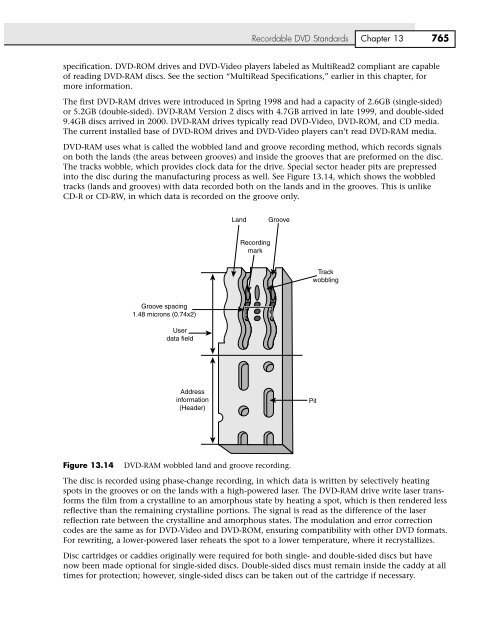Create successful ePaper yourself
Turn your PDF publications into a flip-book with our unique Google optimized e-Paper software.
Recordable DVD Standards Chapter <strong>13</strong> 765<br />
specification. DVD-ROM drives and DVD-Video players labeled as MultiRead2 compliant are capable<br />
of reading DVD-RAM discs. See the section “MultiRead Specifications,” earlier in this chapter, for<br />
more information.<br />
The first DVD-RAM drives were introduced in Spring 1998 and had a capacity of 2.6GB (single-sided)<br />
or 5.2GB (double-sided). DVD-RAM Version 2 discs with 4.7GB arrived in late 1999, and double-sided<br />
9.4GB discs arrived in 2000. DVD-RAM drives typically read DVD-Video, DVD-ROM, and CD media.<br />
The current installed base of DVD-ROM drives and DVD-Video players can’t read DVD-RAM media.<br />
DVD-RAM uses what is called the wobbled land and groove recording method, which records signals<br />
on both the lands (the areas between grooves) and inside the grooves that are preformed on the disc.<br />
The tracks wobble, which provides clock data for the drive. Special sector header pits are prepressed<br />
into the disc during the manufacturing process as well. See Figure <strong>13</strong>.14, which shows the wobbled<br />
tracks (lands and grooves) with data recorded both on the lands and in the grooves. This is unlike<br />
CD-R or CD-RW, in which data is recorded on the groove only.<br />
Groove spacing<br />
1.48 microns (0.74x2)<br />
User<br />
data field<br />
Address<br />
information<br />
(Header)<br />
Land<br />
Recording<br />
mark<br />
Groove<br />
Figure <strong>13</strong>.14 DVD-RAM wobbled land and groove recording.<br />
Track<br />
wobbling<br />
The disc is recorded using phase-change recording, in which data is written by selectively heating<br />
spots in the grooves or on the lands with a high-powered laser. The DVD-RAM drive write laser transforms<br />
the film from a crystalline to an amorphous state by heating a spot, which is then rendered less<br />
reflective than the remaining crystalline portions. The signal is read as the difference of the laser<br />
reflection rate between the crystalline and amorphous states. The modulation and error correction<br />
codes are the same as for DVD-Video and DVD-ROM, ensuring compatibility with other DVD formats.<br />
For rewriting, a lower-powered laser reheats the spot to a lower temperature, where it recrystallizes.<br />
Disc cartridges or caddies originally were required for both single- and double-sided discs but have<br />
now been made optional for single-sided discs. Double-sided discs must remain inside the caddy at all<br />
times for protection; however, single-sided discs can be taken out of the cartridge if necessary.<br />
Pit
















